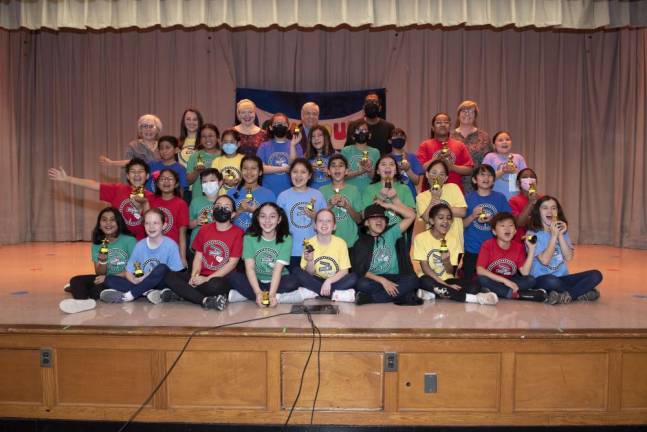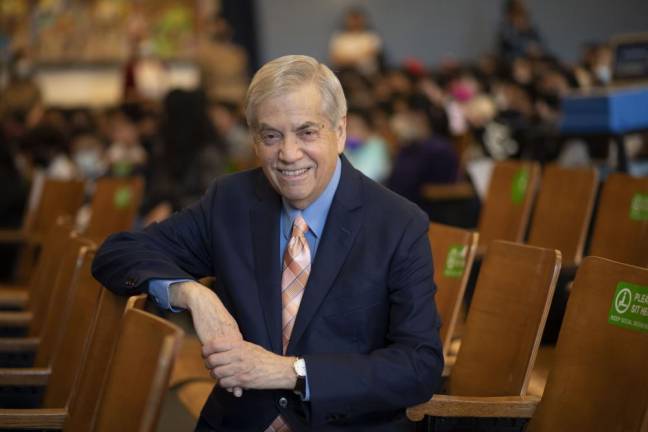Michael Presser remembers standing at the door of the Winter Garden Theatre in 1982 watching the faces of children who were about to see their first Broadway show. Back then, when “Cats” premiered there, he had been asked by the late Bernard Jacobs, president of the Shubert Organization, to help him distribute tickets to New York City public school students for the Wednesday matinees of the show. That free ticket program continued throughout the entire run of the musical, until 2000.
Presser, who was working as an arts management consultant when he was approached by Shubert, is now at the helm of Inside Broadway, the nonprofit that was born as a result of that first generous act 40 years ago. He admits that he never expected its longevity. “In all honesty ... I thought, ‘I’ll try it, and if I do a good job, maybe they’ll give me something else to do,’” he said. Today, the organization serves 90,000 New York City students annually in 100 schools throughout the five boroughs, immersing them in the magic of theater with in-class residency programs, after school workshops and summer camp.
The Greenwich Villager, who moved to New York in 1973 to work in the arts industry, discovered his own love for theater as a child growing up in Philadelphia — a “very active theater town with Broadway tryouts passing through” — seeing shows in their original productions. Now, he gets to share that passion with the youth of the city, which he sees as a very valuable part of their education. “We on Broadway have contributed greatly to American culture and I think, at its best, Broadway has personified what are the strengths of America and American culture, he said. “And I think it’s important for our younger audiences to be aware of that great heritage.”
Tell us how the idea came about.
Bernie had the idea that it would be great, with “Cats” opening on Broadway, for New York City public school students to come to see the Wednesday matinee performance, courtesy of the Shubert Organization. And he asked me to put together the program in conjunction with the city’s Board of Education and Youth Board and City Hall.
What are some memorable moments you’ve seen with students over the years?
I remember many times standing at the door there while we had groups going into the Winter Garden, watching the faces and the responses of kids who had never been in such a fascinating environment. First of all, a Broadway theater, and secondly, “Cats” really transformed the entire building into a set for the show. And it was really fabulous to see their faces light up. Also, a lot of the kids felt that maybe it was like a movie so they could stay and watch it again. [Laughs]
What lessons do the kids take away from the shows?
I’m thinking of the shows that we have produced ourselves in our program, because every year we do a citywide tour of an abridged musical production. And the shows that we have selected for presentation in the schools by the equity performers, have generally been shows with some type of message. For instance, a very successful production we’ve done several times is Duke Ellington’s “Sophisticated Ladies,” a very important African American composer, performer and personality, someone who the younger people today are maybe not as well aware of as they should be. He made a significant contribution to American culture.
Likewise, people like Rodgers and Hammerstein, for instance, and George Gershwin, born in an immigrant family, becoming a world-famous composer and lyricist, and Irving Berlin, who was born in Russia and came to this country as a very young man and became practically a national symbol. This year the show is “My Town,” based on the life of George M. Cohan, considered the father of modern-day Broadway theater.
You also honor Broadway stars through your annual Broadway Beacon Award.
The first person who received the award was the great Carol Channing. And we arranged to present it to her at the Lunt-Fontanne Theatre, where she was appearing in, what else, “Hello, Dolly!.” And at the end of the show — we had children in the audience that day — I went up onto the stage and met with her there. And she was, as she always was, incredibly gracious and positive. And she was very, very interested in the children that day and what they thought of the show and what they wanted to know about her and why she was going to be honored. And people like that are gems. And I think we, as educators, are always looking for role models that we can put in front of students to show them what can be done with your life.
Tell us about your residency programs.
They are the heart of what we do because those programs really involve working directly with children. We call the program Build a Musical. It involves our sending a professional teaching artist, a director, musician or choreographer, directly into the school classroom to work with the children on getting them up on the stage and involved in a musical presentation that they can do in their auditorium. We are in no way pretending that we are training the actors of tomorrow. We’re interested in exposing children to the experience of being in theater, giving them the opportunity to be on a public stage and learning how to present themselves and speak from the stage and get along with their classmates, because theater is a collaborative activity.
How long have you been offering summer camp?
It has operated for over eight years. In summer camp, it’s a different perspective and different group of children because the ones who are in camp are really interested in theater and might like to be in a career in the theater. Many of them have already had or take lessons or have been in some productions. It is a tuition-based program, but we provide scholarships.
What do you think the future looks like for the organization?
When you reach 40 as an organization, we are no longer children and we are no longer teenagers. We are now adults. And because we are adults, we have a larger responsibility for the future and that is to move the organization into the institution status. But the challenge of doing that is a bit complicated because you do not want to become an institution that is so tied down to its institutional practices that it cannot really innovate or create the way you did when you were a young organization. On the other hand, it’s not 1982 anymore, so there’s got to be a mix here of innovation and creativity together with stability and permanence. And there have been wonderful moments in our history and I would hope that for this anniversary year, that we look back a little bit at some of those, but then we also start looking ahead as well.
To learn more about Inside Broadway, visit www.insidebroadway.org

